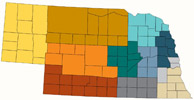Extension, Cooperative

Nebraska Cooperative Extension: Faculty and Staff Publications
Document Type
Article
Date of this Version
2017
Citation
Johnson, L. J., C. A. Shapiro, and A. Millmier Schmidt. 2017. Closing Abandoned Livestock Lagoons Effectively to Utilize Nutrients and Avoid Environmental Problems. In Proceedings of Waste to Worth 2017. April 17-21, 2017. Raleigh, NC. https://lpelc.org/closing-abandoned-livestock-lagoons-effectively-to-utilize-nutrients-and-avoid-environmental-problems /
Abstract
In Nebraska alone, nearly 400 earthen manure storage structures are in operation; approximately four dozen requests to cease operation of permitted lagoons were received by the Nebraska Department of Environmental Quality in the prior decade with many more non-permitted storage structures being in need of proper closure. Abandoned livestock lagoons, earthen manure storage basins, and other manure storages (e.g. concrete pits) need to be decommissioned in a manner that controls potential environmental risk and makes economical use of accumulated nutrients. Currently, limited guidance is available to support lagoon closure planning and implementation and few professionals who support livestock producers have experience planning or participating in the manure storage closure process. The main focus of this project was to produce two videos that document the processes for planning and executing a lagoon closure.
The University of Nebraska Haskell Ag Laboratory, located near Concord, NE, had an anaerobic lagoon that was operated for over 20 years, but has not received swine manure additions since 2009 when the swine unit was depopulated. The decommissioning of this storage structure was proposed in 2014 and provided our team an opportunity to plan, implement and document the procedures necessary to properly close this structure. When we went to find material on how to accomplish this properly, we did not find suitable material. Two grants were secured in 2016 from the U.S. Pork Center of Excellence (USPCE) to fund our team efforts to document the closure process – from planning to completion – with two separate videos. The first video is focused on the planning activities necessary to prepare for removal and utilization of stored liquid and sludge. The second is focused on the liquid and sludge removal and utilization activities, decommissioning of conveyance structures, and deconstruction of the lagoon berm to return the site to a natural grade.
Included in
Agricultural and Resource Economics Commons, Agricultural Education Commons, Food Science Commons, Rural Sociology Commons

